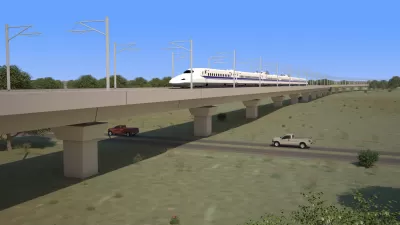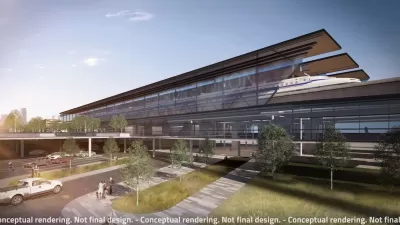In August, Amtrak received a $63.9 million grant from the FRA to continue its work to identify a high-speed rail corridor between Dallas and Houston.

“Despite some naysayers saying that the high-speed rail project between Dallas and Houston is DOA and others trying their best to kill it, there is still slow but steady movement on this critical infrastructure project that would connect the two mega-cities in about 90 minutes,” according to an article from Texas Rail Advocates. Planetizen reported small movements forward in April when Amtrak took the lead on the project, as well as in May and July. Next, “In August the Federal Railroad Administration (FRA) granted $63.9 million for Amtrak to continue planning and advancing the project that Texas Central Railway brought close to the construction stage,” according to the Texas Rail Advocates article.
Amtrak Senior Vice-President for High Speed Rail Andy Byford told the Texas Rail Advocates that the project has progressed to the third and final step of the FRA Corridor Identification Program and that, while it’s by no means a done deal, he’s pleased with the progress. The article discusses several of the obstacles the project has faced since the pandemic stopped work for nearly two years, including extensive criticism as outlined in this article from the Daily Caller, but assures readers that while the project may look like it’s in a holding pattern, “There is still a lot of behind the scenes work going on with Texas Central and some of the original investors and players are still active while Amtrak works toward bringing the project forward.”
FULL STORY: Wake up! High-speed rail Dallas to Houston: it's still moving along

Alabama: Trump Terminates Settlements for Black Communities Harmed By Raw Sewage
Trump deemed the landmark civil rights agreement “illegal DEI and environmental justice policy.”

Planetizen Federal Action Tracker
A weekly monitor of how Trump’s orders and actions are impacting planners and planning in America.

Why Should We Subsidize Public Transportation?
Many public transit agencies face financial stress due to rising costs, declining fare revenue, and declining subsidies. Transit advocates must provide a strong business case for increasing public transit funding.

Understanding Road Diets
An explainer from Momentum highlights the advantages of reducing vehicle lanes in favor of more bike, transit, and pedestrian infrastructure.

New California Law Regulates Warehouse Pollution
A new law tightens building and emissions regulations for large distribution warehouses to mitigate air pollution and traffic in surrounding communities.

Phoenix Announces Opening Date for Light Rail Extension
The South Central extension will connect South Phoenix to downtown and other major hubs starting on June 7.
Urban Design for Planners 1: Software Tools
This six-course series explores essential urban design concepts using open source software and equips planners with the tools they need to participate fully in the urban design process.
Planning for Universal Design
Learn the tools for implementing Universal Design in planning regulations.
Caltrans
Smith Gee Studio
Institute for Housing and Urban Development Studies (IHS)
City of Grandview
Harvard GSD Executive Education
Toledo-Lucas County Plan Commissions
Salt Lake City
NYU Wagner Graduate School of Public Service





























